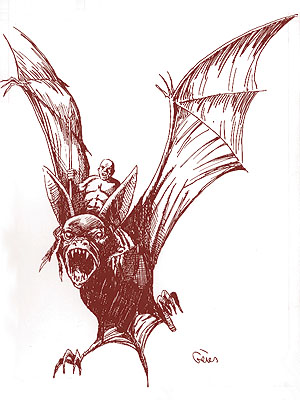
Skinwing
The skinwing is a reptilian, bat-like creature found in warm climates. A skinwing resembles a furless bat with dirty brown scales. Its wings are utterly hairless and resemble tough, leathery skin. A skinwing has large black eyes that function well in both dim and bright light. Skinwings have a wingspan of about three feet per Hit Die. Their bodies are quite small in comparison to their wings, usually about one foot long per Hit Die.
Orcs commonly keep these creatures as mounts. The lizardmen of Shazak sometimes use them as mounts, although they prefer to use giant bats.
The Red Curse: Some skinwings (25%) have Legacies from Region 3. Typical skinwing Legacies include Anti-Missile and Gaseous Form. Skinwings do not require cinnabryl.
Combat: A skinwing attacks with either its teeth or claws. If it uses its bite attack (2d4), it must either land or fly very slowly. The skinwing is AC 7 only if it uses this mode of attack. If the skinwing uses its claw/claw attack, it rakes its sharp claws across the top or back of its prey and flies out of range before the creature can retaliate. The flock usually attacks a single target, and each member gets an attack against that target. A flock of skinwings can bring down large prey using this manoeuvre.
If both claws attacks are successful and the victim is less than one-half of the maximum weight the skinwing can carry, the skinwing carries the victim aloft. Thereafter, the skinwing inflicts 2d4 points of damage per round.
A skinwing can carry a rider, albeit for short distances, but it must have a drop-off in order to become airborne. A skinwing can carry about 30 pounds per Hit Die. A 4 Hit Die skinwing could thus carry a load of 120 pounds. Skinwings cannot fly higher than about 1,000 feet. Above that altitude, the air is too cold for them.
While carrying a rider, the skinwing must make a successful saving throw vs. paralysation every half hour in order to continue flying. If the saving throw fails, the skinwing is exhausted and must land immediately. Skinwings cannot attack if they are carrying a rider.
Skinwings who have taken 50% or more damage can no longer fly until they are fully healed.
Habitat/Society: A skinwing usually will not attack man-sized or larger creatures unless it has been trained to do so. A flock of skinwings will attack a larger creature only if they are very hungry.
Skinwings are very hard to train. Once they are trained, however, they make superior mounts, able to anticipate their riders' needs. A trained skinwing gets a +1 bonus to morale.
While skinwings can be found almost anywhere, they prefer warmer climes, since they have a reptilian heritage. They live in caves, dark buildings, or heavily shrouded forests and feed during the day, when they are most active.
Ecology: Skinwings
are predators and scavengers. They will eat carrion and insects. The wings of a
skinwing can be cured into a high quality leather.
